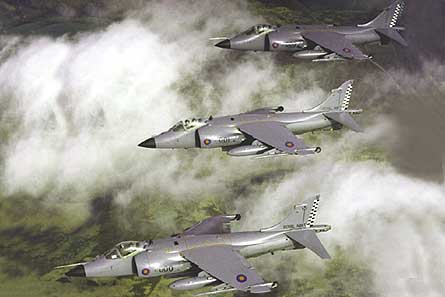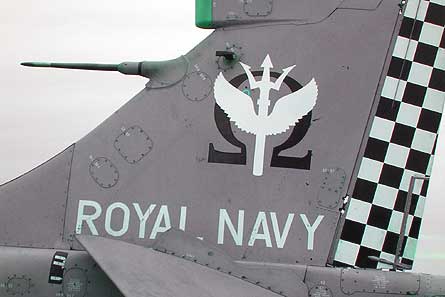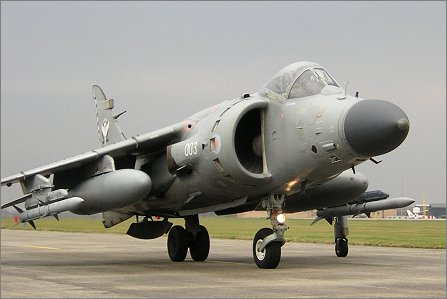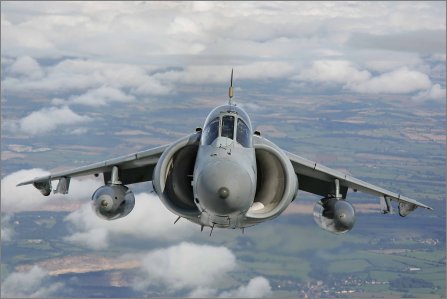The UK Royal Navy will mourn the retirement of its last Sea Harrier fighters this week, but its Fleet Air Arm is far from finished as a fast-jet power
Twenty-four years after gaining legendary status during the Falklands War, the UK Royal Navy’s last British Aerospace Sea Harrier fighters will be retired this week, completing the service’s transition to conducting joint fast jet operations with the Royal Air Force. The Fleet Air Arm will observe this end of an era at RNAS Yeovilton in Somerset on 28 March, when its last six Sea Harrier FA2s will be decommissioned, along with its last operational fast-jet squadron to fly the type: 801 NAS. The aircraft will be flown to RAF Shawbury in Shropshire the next day and be placed in storage while discussions over their possible transfer to India can be concluded over the coming months.
|
| The fighter, reconnaissance and strike mark I (FRS1) was the first variant |
The standing down of 801 NAS will draw a line under 25 years of Sea Harrier operations by the unit, which logged its most notable missions with the FRS1 variant during 1982’s Falklands/Malvinas conflict, when its aircraft recorded eight air-to-air kills. The squadron – which later also flew combat sorties over Bosnia-Herzegovina and Sierra Leone – bowed out on an operational high on 9 March, when five of its fighters participated in a farewell sortie flown against a “hostile” formation of four RAF Panavia Tornado GR4s, two Sepecat Jaguar GR3s and five US Air Force Boeing F-15Cs. The Sea Harrier formation recorded “kills” against all the rival force for the “loss” of just one aircraft, the squadron says.
|
Final farewell
Equipped with Blue Vixen multi-mode radar and armed with Raytheon AIM-120 AMRAAM medium-range air-to-air missiles, the FA2 has for more than a decade provided the UK with an aircraft carrier-capable air defence service. The type was embarked aboard an RN vessel for the last time on 28 February, following a 2002 Ministry of Defence decision to retire the fleet early rather than find an expensive and technically risky further upgrade to the Sea Harrier design.
“Although the FA2 has a capable air-defence weapons system, post-2006 it would require significant investment to remain credible until the Joint Combat Aircraft [Lockheed Martin’s F-35 Joint Strike Fighter] enters service towards the middle of the next decade,” the navy says. A possible upgrade to the FA2 would have included replacement of its Rolls-Royce Pegasus 106 engine, which provides limited operating margin and weapons bring-back capability in hot conditions.
These factors led to the conclusion that the FA2 was “less viable as a platform” than the BAE Systems Harrier GR7A and upgraded GR9 platforms, says Cdr Henry Mitchell, the RN’s Commander Sea Harrier Force. The GR7/9 “is a much more relevant platform for power projection” and offers greater flexibility to support allied troops on the ground, he says. “In the Cold War bring-back was a paper exercise. Recently it has been a big issue.”
But the removal from service of its last six FA2s and two Sea Harrier T8 trainers is not the end for the RN’s fighter force. Joint Force Harrier’s squadron structure is to be transformed from 31 March, on the way to its eventual complement of four squadrons of BAE-modified Harrier GR9/9As. The Harrier GR7/7As of the RAF’s 3 Sqn will be transferred late this week to revive 800 NAS, which previously operated the Sea Harrier.
|
| The RN's last Sea Harrier FA2s only saw 10 years of service |
Disbanded in March 2004, the newly revived 800 NAS could soon be deployed to Afghanistan as part of a planned rotation to the UK’s current GR7A deployment at Kandahar airbase. The revival of 800 NAS will coincide with the rebranding of 3 Sqn as the RAF’s first frontline unit to be equipped with the Eurofighter Typhoon. Operations of the multi-role fighter will be based at RAF Coningsby in Lincolnshire, which already houses the UK’s Typhoon operational evaluation and operational conversion units.
Joint Force Harrier will eventually comprise two RAF and two RN squadrons and have a roughly 50:50 split of pilots from the two services – a balance that will be retained as the UK transitions to future operations of the Joint Strike Fighter. All the command’s four frontline squadrons will be home-based at RAF Cottesmore in Rutland and supported by the RAF’s 20 Sqn operational conversion unit at nearby RAF Wittering in Lincolnshire. Meanwhile, 801 NAS will be reborn on 1 October, with the squadron to achieve full operational capability with the Harrier GR7/9 on 1 April 2007.
The future RAF and RN Harrier squadrons will be largely populated by personnel from the respective services, although the navy says a degree of “cross-pollination” will be retained to ensure that the units retain common skills and do not develop different specialities. “We have a common bond in terms of what we want to achieve in terms of airpower,” says Mitchell.
Two of 801 Sqn’s FA2s were delivered to RNAS Culdrose in Cornwall in late February to support aircraft-handler ground training, with one of its T8 trainers to be delivered to the facility this week. The majority of the squadron’s pilots have already transitioned on to the Harrier GR7/7A, although three have accepted instructor positions at RAF bases Linton-on-Ouse in Yorkshire and Valley in North Wales. Many of the unit’s junior ratings have moved to support Harrier operations at Cottesmore and Wittering, although a number of more experienced support personnel have decided not to follow suit.
Engine trouble
While the FA2 performed admirably on its final operational exercise, recent use of the type has been marred by reliability issues linked to a fan blade upgrade to its Pegasus 106. Intended to improve the powerplant’s resistance to foreign object damage, the modification resulted in increased engine vibration and a reduction in individual blade life from 500h to around 90h.
BAe FA2 SEA | HARRIER |
Engine | 1x Rolls-Royce Pegasus 106, producing 21,500lb (95.6kN) |
Max speed (sea level) | 540kt (1,000km/h) |
Max operating altitude | 45,000ft (13,700m) |
Weapons loads | 4 x Raytheon AIM-120 AMRAAMs; 2 x AMRAAMs and 4 x Raytheon AIM-9 Sidewinders; or 3 x 450kg (1,000lb) bombs and 30mm cannon |
The RN had expected to conduct five engine changes on its remaining Sea Harriers through the type’s final 18 months of operations, but was forced to conduct 43, largely as a result of the reliability issue.
Mitchell acknowledges that losing the Sea Harrier’s beyond-visual-range air-to-air missile capability will strip the UK of one level of its current air defence cover, but says this shortfall can be remedied during joint operations with allied nations. “With the JSF that gap will be firmly closed,” he adds. Current plans call for the UK acquisition of the short take-off and vertical landing F-35B, although issues with US technology transfer could threaten its proposed purchase of the JSF (Flight International, 21-27 March). The UK’s new Joint Combat Aircraft will conduct land operations from RAF Lossiemouth in Scotland, with Cottesmore and RAF Marham in Norfolk shortlisted should a second base be required for the type.
Passage to India
India is negotiating the possible purchase of eight ex-RN FA2s, having voiced interest in the type around six months ago. If delivered, the fighters will bolster the Indian navy’s fleet of 16 Pegasus 104-powered Sea Harrier FRS51s, with the service having lost six in accidents over the past 24 years.
|
| Eight of the RN's retired Sea Harriers could be heading to India |
India’s FRS51s will by late 2007 complete a Hindustan Aeronautics-conducted upgrade, which will equip them with Elta’s EL/M-2032 fire-control radar and Rafael’s Derby beyond-visual-range air-to-air missile.
A UK MoD source close to the negotiations says an Indian delegation has already inspected the FA2s at Yeovilton, but that the agreement of a “meaningful” long-term support package with original equipment manufacturers BAE and R-R will be vital to concluding an aircraft transfer “within the next few months”. The potential sale will not include the FA2’s Blue Vixen radar, AMRAAM air-to-air missiles or radar-warning receiver equipment, while some US-sourced software will also have to be removed from the 10-year-old aircraft.
CRAIG HOYLE / RNAS YEOVILTON
Blog:
Read defence editor Craig Hoyle's first hand account of exactly what it's like to fly a multi-million dollar fighter very low and very, very fast when he has the opportunity to fly in – and take control of – a Royal Air Force Harrier T10 trainer
Cutaways:
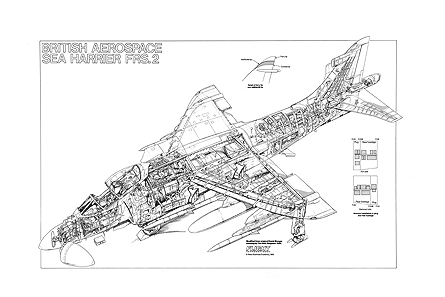 |
| Flight International produced cutaway drawings of the Sea Harrier FRS1 and FRS2 – the latter of which was later redesignated the Sea Harrier FA2 (pictured above). Order your high resolution copies from the Flight Collection by clicking this link to email Paul Gladman, or by calling him (09:00-17:00 UK time) on +44 20 8652 3428 |
Source: Flight International





















